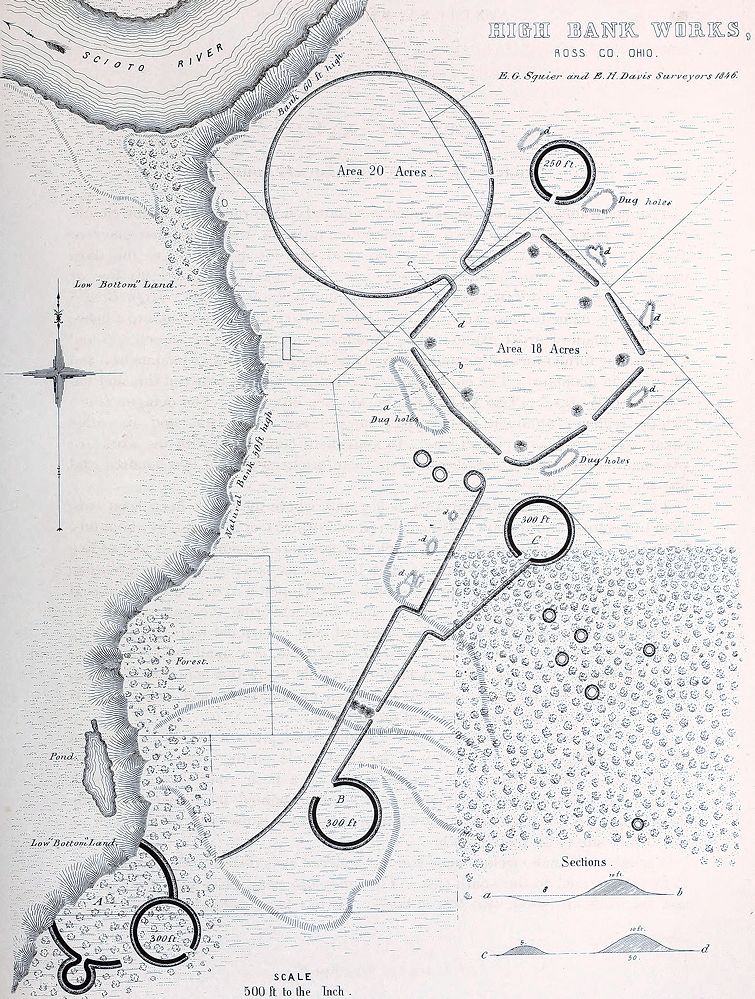PLATE XVI
HIGH BANK WORKS, ROSS COUNTY, OHIO.
The beautiful group here represented is situated on the right bank of the Scioto river, five miles below the town of Chillicothe, near the road from that place to Jackson. It occurs at a place where the river has cut its way up to the third terrace, which in consequence here presents a bold bank, rising seventy-five or eighty feet above the water. This point is generally known as the " High Bank" and gives its name to these works. The third terrace here spreads out into a beautiful, level plain of great extent. The principal work consists of an octagon and a circle; the former measuring nine hundred and fifty feet, the latter ten hundred and fifty feet, in diameter. The coincidences, in the dimensions, between this and the "Hopeton Works," (Plate XVII,) will be at once observed. The octagon is not strictly regular; although its alternate angles are coincident, and its sides equal. The circle is a perfect one. In immediate connection with the work are two small circles, which are shown in the plan, each measuring two hundred and fifty feet in diameter.
The walls of the octagon are very bold; and, where they have been least subjected to cultivation, are now between eleven and twelve feet in height, by about fifty feet base. The wall of the circle is much less, nowhere measuring over four or five feet in altitude. In all these respects, as in the absence of a ditch and the presence of the two small circles, this work resembles the Hopeton Works already alluded
to. There are no mounds, except the small ones covering the gateways of the octagon. About half a mile to the southward, and connected with this work by lines of embankment, much reduced but still traceable, is a small group of works, partially destroyed by the river. A fourth of a mile below this subordinate group, on the bank of the terrace, is a large truncated mound, thirty feet in height. It does not fall within the area exhibited on the map.
At various points around this work are the usual pits or dug holes, some of which are of large size. To the left of the great circle, on the brow of the terrace, is an Indian burial place. The construction of a farm road down the bank disclosed a large quantity of human bones, accompanied by a variety of rude implements. A short distance below this point, on the same bank of the river, is the former site of an Indian town.
A number of small circles occur about a hundred rods distant from the octagon, in the forest land to the south-east. They measure nearly fifty feet in diameter, and the walls are about two feet in height. It has been suggested that they are the remains of structures of some kind, and also that they were the bases of unfinished mounds. There are no indications of entrances or passage ways, a circumstance which favors the latter hypothesis. Similar small circles occur within or in the immediate vicinity of several other large works.
Ephraim George Squier and Edwin Hamilton Davis, Ancient Monuments of the Mississippi Valley: Comprising the Results of Extensive Original Surveys and Explorations (1848).
| |

| |
2005.05.03 15:02
Minimalism in Architecture
I visited the ICA exhibition and two of the 36 projects. My favorite was at the Arcadia University Art Gallery. Although not a very large space (approx. 30' x 55' white walls and light gray floor), when first entering the space it appeared as if empty. It was fun and even enlightening to ultimately see the 50 odds works exhibited--kind of nothingness in the extreme.
Going back to the original post, could it be that McMansions really don't have any real competition from the architecture field? Are today's architects even capable of offering what most people want in a home without going against what they are taught? My graduation from architecture school coincided with my parents moving to a new house, and I was given the old house. One of the first things I did to makeover the place was to strip off all the wallpaper, and I found 'virgin' plaster walls. I then decided to not paint any room white, which is when I realized I knew/was taught virtually nothing about color. It took a lot of effort and many, many hours studying paint chips, and even some repainting, but eventually I learned how to judge color with respect to rooms. Granted, painting rooms different colors isn't architecture, but the experience did demonstrate something that I wasn't taught in school with regard to 'designing' a living environment.
Here's another anecdote:
Back in 1977, I and a small group of fellow arch. students got a private tour of Kahn's Esherick House. You could say it's a nice little minimal work, inside and out--I'd move in in a minute. What was shocking, however, was the kitchen, which is totally a design by the wood sculpture Esherick (who was somehow related to the original owners). The whole room is like a room size free-flowing and curvy wood sculpture. The then owners said they had known Kahn when they bought the place, and whenever he visited he couldn't stand to stay in the kitchen more than a few seconds, and being in the room always made him say something nasty.
|